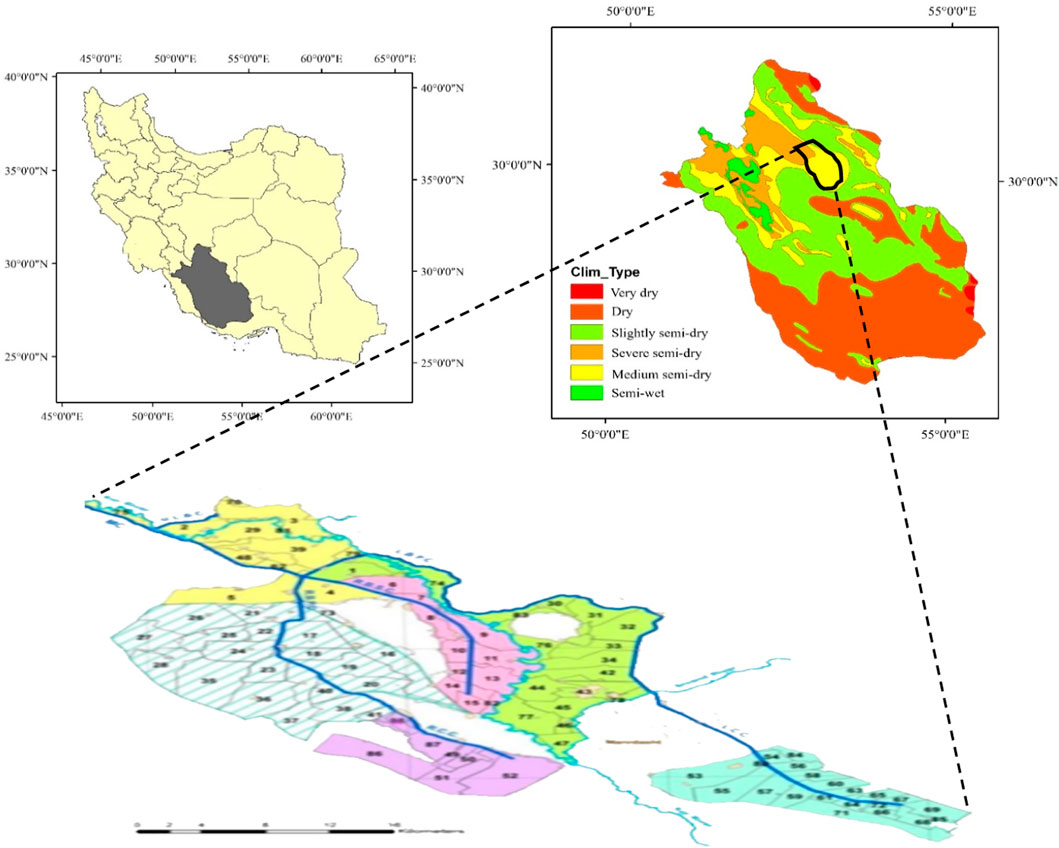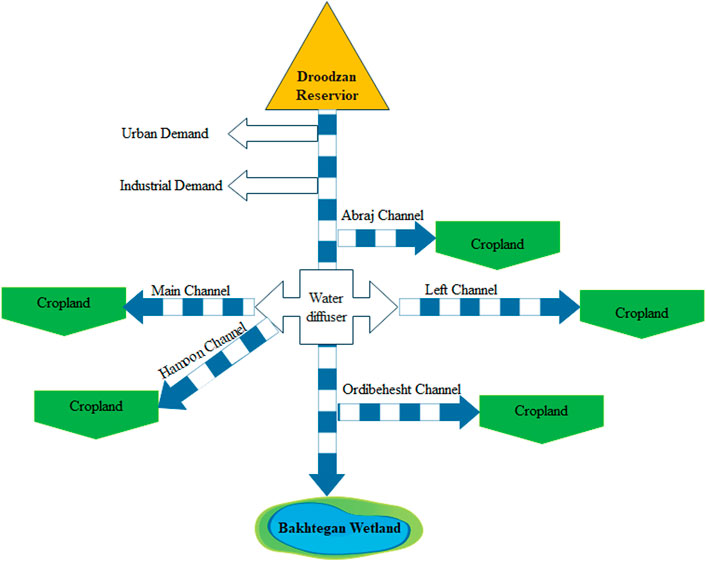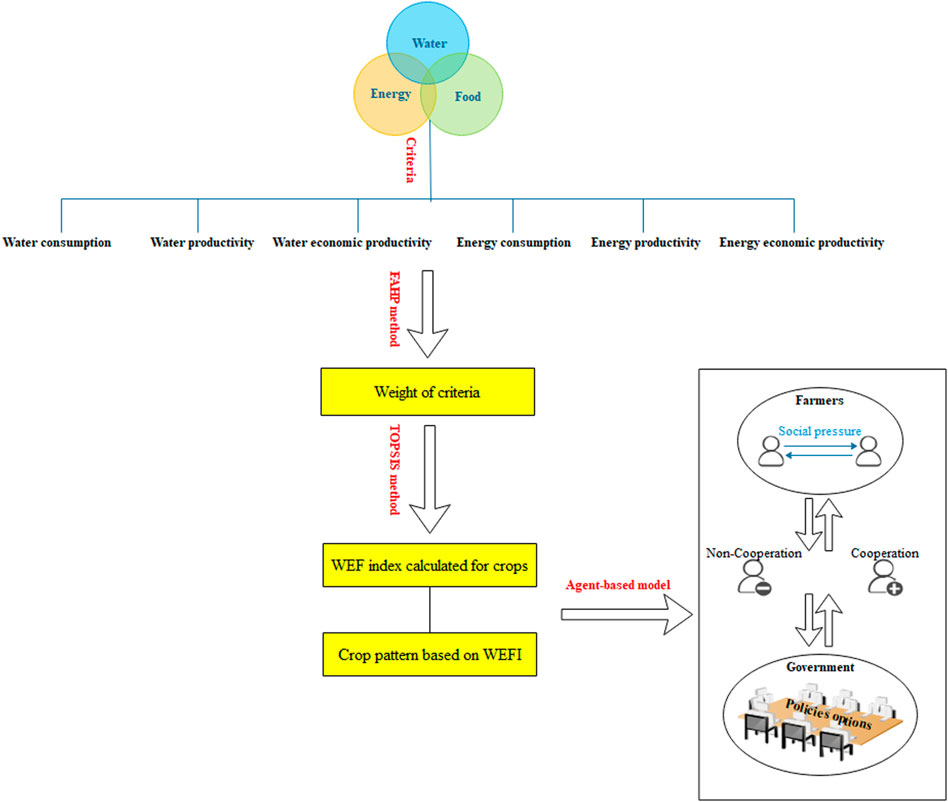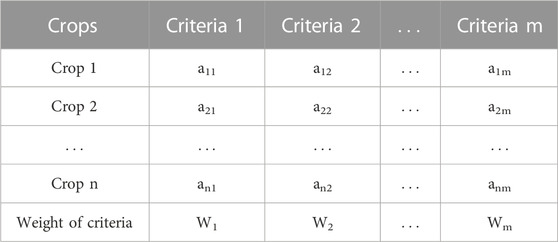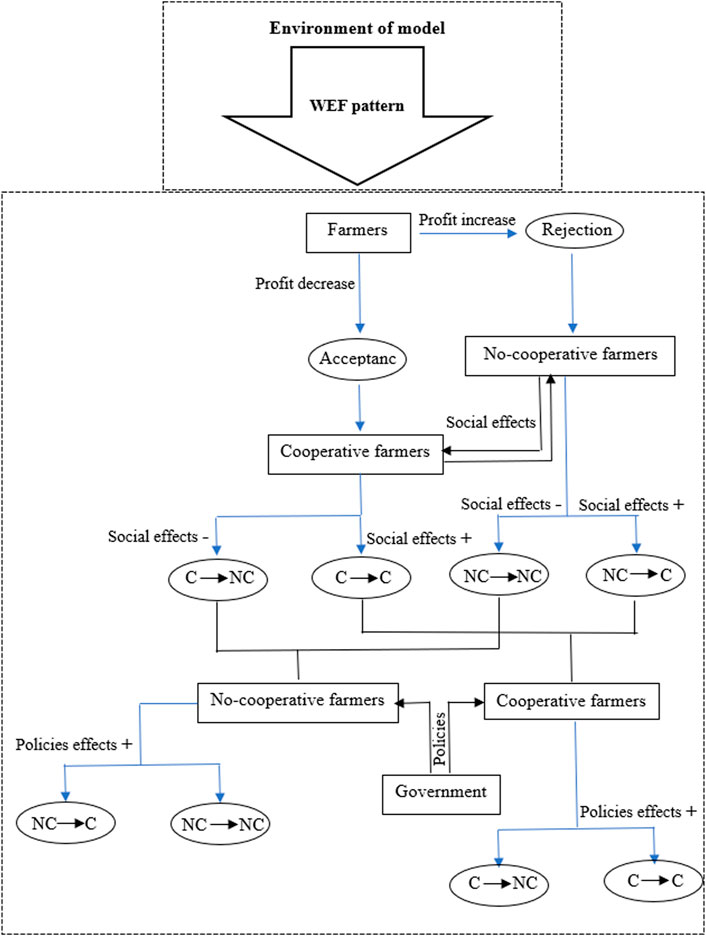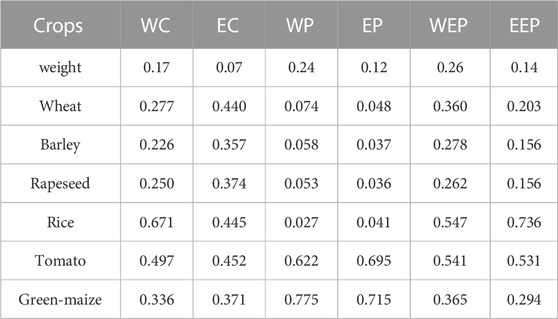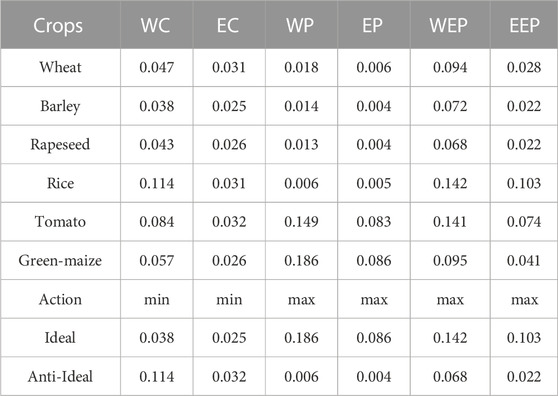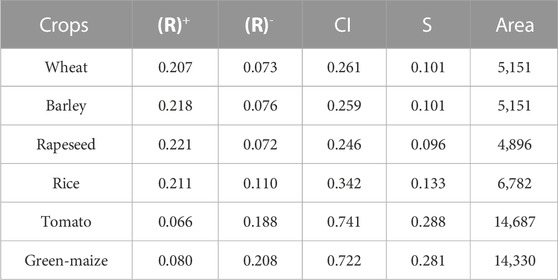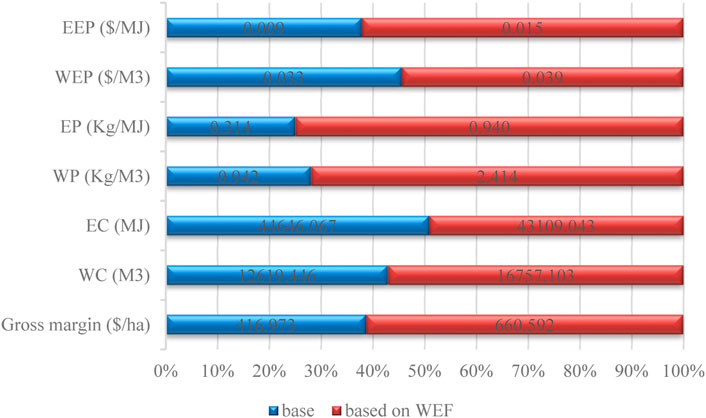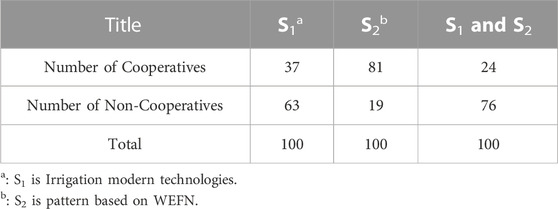- 1Department of Agricultural Economics, Agricultural Sciences and Natural Resources University of Khuzestan, Mollasani, Iran
- 2Department of Food Science and Technology, Agricultural Sciences and Natural Resources University of Khuzestan, Mollasani, Iran
In recent years, water-scarce regions (WSRs) have faced many challenges in order to achieve sustainable economic development. Sustainable economic development in the agricultural sector of WSRs is possible by paying attention to the water-energy-food nexus (WEFN) concept. WEFN determined using consumption, physical productivity, and economic productivity criteria of water and energy resources. According to the goals of physical and economic productivity of water and energy resources, it will be very difficult to implement WEF nexus patterns in WSRs with severe water resource crisis. The present study is aimed in WSRs to extract the resource allocation pattern based on the goals of the WEFN system using multi-criteria decision making (MCDM) tools and evaluate the cooperative behavior of farmers with this pattern under government’s policy options using an agent-based model (ABM). The results for Doroodzan dam irrigation network as a WSR revealed that the pattern based on WEFN will lead to a 200 and 18 percent increase in physical and economic water productivity and a 156 and 67 percent increase in physical and economic energy productivity compared to the base pattern, but the implementation of this pattern requires 33% more water consumption. Therefore, it is very necessary to water resource management policies such as using modern irrigation technologies under government policy options in order to implement the pattern based on WEFN in WSRs. In this regard, the inflexibility of the government’s policies will prevent the widespread implementation of the pattern based on WEFN and sustainable economic development at the regional level. Also, it can be concluded that the expansion of sustainable patterns in the agricultural sector will not be possible without considering the situation of the region from the point of view of water resources and also the cooperative behavior of the farmers. Finally, the framework of the present study is recommended to achieve the goals of sustainable economic development of the agricultural sector in WSRs.
1 Introduction
In recent years, the increase in demand for agricultural products arising from population growth, economic development and urbanization has resulted into an increase in water and energy use for food production (Karabulut et al., 2016; Radmehr et al., 2021). A global shortage of food caused by increasing competition for the consumption of limited water and energy resources in the agricultural sector along with climate change is a predictable event (Steffen et al., 2015; Pastor et al., 2019; Abdelkader and Elshorbagy, 2021). Agriculture accounts for about 90% of fresh water consumption and about 30% of energy use around the world (FAO, 2011). On the other hand, agricultural irrigation provides about 40% of the world’s food (Li et al., 2022). Thus, water, energy and food, as the basic needs of human life, are regarded as important components for sustainable economic development studies of human communities (Wen et al., 2022).
The analysis of the water-energy-food nexus (WEFN) is necessary for sustainable management of water and energy resources in the agricultural sector and ensures food security, namely in water-scarce regions (WSRs) around the world (Stephan et al., 2018; Mirzaei et al., 2022a). The WEFN term was proposed in early 2010 for the integrated management of the three critical resources of water, energy and food (Hoff, 2011; Scott et al., 2015; Vanham et al., 2019; Guan et al., 2020). Several conceptual frameworks have been designed to analyze the WEFN (Gain et al., 2015; Mayor et al., 2015; Guan et al., 2020). In various studies, WEFN has been analyzed through life cycle (Albrecht et al., 2018), water footprint theory (Hung, 2002; Ramaswami et al., 2017; Zhang et al., 2019; Lee et al., 2020), optimization models (Jalilov et al., 2016; González-Bravo et al., 2018; Li et al., 2019a; Li et al., 2019b; Wicaksono and Kang, 2019; Sun et al., 2020; Yu et al., 2020; Radmehr et al., 2021; Mirzaei et al., 2022a; Li et al., 2022), input-output data (Xiao et al., 2019), social analysis (White et al., 2017) composite sustainability indices (Dizdaroglu, 2017; El-Gafy et al., 2017; Farinha et al., 2019; Nhamo et al., 2020; Sadeghi et al., 2020; Saray et al., 2022) and system dynamics models (Wa’el et al., 2018; Hu et al., 2019; Tan and Yap, 2019; Wen et al., 2022).
Considering the relationship between water, energy and agriculture sectors and the different goals of these sectors (Chen et al., 2017; Yu et al., 2020), it is necessary to use multi-objective and multi-criteria decision-making models, because considering only the goal of one sector of the three sectors of water, energy and food, may result into misleading results (Bizikova et al., 2013). Therefore, providing a composite index by including all criteria related to water, energy and food can be used as a comprehensive tool to examine the aspects and concerns related to all three sectors (El-Gafy et al., 2017; Nhamo et al., 2020; Sadeghi et al., 2020). For example, Nhamo et al. (2020) estimated the WEFN index using Analytical hierarchy process (AHP) method as a multi-criteria decision-making method. In this study, the WEFN index was calculated as a sustainable development index for South Africa in the two time periods of 2015 and 2018 and the sustainability condition was also evaluated. Radmehr et al. (2021) used the multi-objective optimization model with the goal of maximizing the benefits of the agricultural, urban and industrial sectors and minimizing the destruction of groundwater resources with the restrictions of water and energy resources, and extracted a set of optimal Pareto solutions. Also, by using multi-criteria decision-making methods, and the criteria related to WEFN, they selected the best solution and proposed the appropriate cropping pattern. Sadeghi et al. (2020), Mirzaei et al. (2022a) and Saray et al. (2022) combined the criteria related to the linkage between the water, energy and food sectors, and calculated the WEFN index for different crops in a studied area and then maximized the WEFN index along with other economic and environmental goals using the optimization models.
On the other hand, the optimal agricultural management with the WEFN approach will not be efficient without considering the cooperative behavior of farmers (Radmehr et al., 2021). Hoolohan et al. (2018) argued that stakeholders play a very important role in the development of WEFN tools. Thus, the main focus of this study is the analysis of farmers’ cooperation with the extracted patterns obtained from the goals of the WEFN system. By determining an optimal pattern without the adequate cooperation of farmers to implement this model, we observe failure at the operating level definitely. In other words, it is necessary to examine the operational and applicability of the optimal patterns at the regional level, as agent-based models (ABM) are used to simulate these behavioral and social complexities on a wide scale, namely in the water resources management (Bandini et al., 2009; Akhbari and Grigg, 2013; Farhadi et al., 2016; Mirzaei and Zibaei, 2021; Mirzaei and Azarm, 2022). For example, Akhbari and Grigg (2013) investigated consumer conflict resolution in the San Joaquin watershed in California using the ABM. In this study, the three objectives of maximizing water withdrawal for agricultural purposes, maximizing the water output to the wetland and minimizing the salt loaded by the water used in agriculture were considered as the purposes of the study and an optimal and applicable solution at the basin level was presented. Farhadi et al. (2016) used an ABM framework for the sustainable management of groundwater in Darayan, Maharlo, Tashk and Bakhtegan lakes in Fars province in Iran. For this purpose, a multi-objective optimization model was used with the purpose of reducing irrigation water, increasing equality in water allocation and reducing groundwater extraction in order to achieve Pareto optimal solution and Nash bargaining model to achieve a consensus among the stakeholders. Then, an ABM model was implemented to examine social factors and policy mechanism to encourage stakeholders to participate in management decisions. Using the ABM, Mirzaei and Zibaei (2021) evaluated the participatory behavior of farmers with optimal patterns under the effect of adaptive strategies to climate change in the Halil River basin with the aim of reviving the Jazmourian wetland in this basin.
According to the literature review, multi-objective mathematical programming methods have been applied in order to achieve the goals of the WEFN and to determine an appropriate pattern for these goals. However, the present study attempts to determine the pattern of resources optimal allocation in a WSR by using multi-criteria decision-making methods and considering the goals of the WEFN. Despite multi-objective mathematical programming methods, this evaluation method formulates complex issues, criteria and goals simply, and extracts suitable solutions by considering the opinion of experts and decision makers (Nhamo et al., 2020). On the other hand, no study has been conducted in the world to examine the participatory behavior of farmers with patterns extracted from the WEFN system, and this study is considered the first one in this field. Thus, the present study is aimed to extract the cropping pattern and resources allocation based on the goals and criteria of the WEFN system in an arid and semi-arid region with serious water resource scarcity (WSR) through multi-criteria decision-making methods and then analyzing the cooperative behavior of farmers and the government’s policy options to encourage farmers with an extracting model. For this purpose, the irrigation network of Doroodzan dam in Fars province, Iran is considered as a WSR.
2 The study area
Fars province in Iran is one of the most important agricultural regions, and it is considered one of the WSRs of the world. The average rainfall in this province was about 322 mm during the years 1992–2013, and this province encountered severe droughts between 2003 and 2011 (Mirzaei et al., 2022b). Also, predictions indicate that in the future, the temperature will increase and soil moisture will decrease in Fars province (Gandomkar and Dehghani, 2012). Doroodzan Dam basin in Fars province is one of the most important regions in Iran, and Bakhtegan Lake is located at the end of this region. This lake is the second largest lake in Iran in terms of size and is classified as a national park (Tarazkar, 2016). This lake is fed by Kor River, which originates from the heights of the Zagros mountains. Doroodzan dam’s irrigation network (Ramjerd plain irrigation network) is one of the important agricultural areas in this basin, which is considered as the study area. This irrigation network is located in the northwest of Fars province and is fed from the outlet of Doroodzan Dam (Figure 1). The water released from the Doroodzan Dam enters the main channel of the irrigation network of the Doroodzan and before reaching the water distribution structure, a part of water is allocated for drinking and industrial purposes. Also, the Abraj canal is located before the distribution water structure. In the distribution water structure, the water branches into 4, main, left, Hamon and Ordibehesht canals. Abaraj canal, which is located before the water distribution structure, has a length of about 5 km and this canal covers 1934 ha of agricultural land. The canals branched from the distribution water structure include the main, left, Hamoon and Ordibehesht canals, which have a length of 22, 67, 34 and 22 km, respectively, and each of these canals cover about 6,108, 22,096, 15,946 and 5,430 ha of agricultural fields (Figure 2).
3 Materials and methods
3.1 Data
In the present study, the data required to extract the resources allocation pattern based on the WEFN, including the information related to the technical coefficients of the production inputs and the crops production cost, were extracted from the farmers of the study area via the design of questionnaires and interviews. For this purpose, a sample of farmers supported by the irrigation network of Doroodzan Dam was chosen using multi-stage random sampling method. In this way, at first, the villages covered by this irrigation network were divided into three categories, low, medium and high by the clustering method, based on the amount of water withdrawal. Then, some villages were selected using simple random sampling from each category according to the total number of villages in that category. Finally, 100 sample farmers were determined based on the population of farmers in the villages using the simple random sampling method. Also, the data related to the cultivation area, the amount of water resource consumption, crop yield and the amount of consumption of other production inputs per unit area, are based on agricultural service centers, agricultural jihad and Fars regional water Company. Then, a pair-wise comparison questionnaire of the WEFN criteria was completed via 10 economic and environmental experts and, the weight of the WEFN criteria was calculated in accordance with this information. Ultimately, in order to analyze the ABM, interviews were conducted with the sample farmers in the study area and the given policy options were shared with them.
3.2 Conceptual framework
The conceptual framework of the study is depicted in Figure 3. The criteria related to the WEFN were determined according to the review of the literature in this field (El-Gafy et al., 2017; González-Bravo et al., 2018; Nhamo et al., 2020; Sadeghi et al., 2020; Radmehr et al., 2021; Mirzaei et al., 2022a; Saray et al., 2022). The energy consumption data in the production of different crops can be calculated via the energy equivalent of the consumption production inputs (El-Gafy et al., 2017; Sadeghi et al., 2020). The water and energy physical productivity criteria (Wp and Ep) for different crops (c) are obtained from the ratio of crop yield (Y) to the amount of water and energy consumption (W and E) of that crop per unit area.
The water and energy economic productivity measures (Wep and Eep) were also obtained from the ratio of the gross margin (GM) of the crop to water and energy consumption of that product per area unit.
In the second stage, the weight of the importance of these criteria was obtained from the experts’ opinion (Nhamo et al., 2020). For this purpose, the WEFN index was calculated by separating the crops in the cropping pattern using the fuzzy analytic hierarchy process (FAHP) method and then the TOPSIS method. In the third step, based on the existing cultivation area, the cropping pattern was determined according to the WEFN index. In the final stage, the resources allocation pattern based on the WEFN along with the policy options was shared with the given sample farmers and the cooperation or non-cooperation of farmers with the proposed model with and without the government’s policy options was evaluated by the ABM. (Akhbari and Grigg, 2013; Akhbari and Grigg, 2015; Guo et al., 2022; Mirzaei and Azarm, 2022).
3.3 Research methods
3.3.1 FAHP and TOPSIS
In the present study, the Fuzzy Analytic Hierarchy Process (FAHP) is used which was presented by Chang in 1996 as a quantitative analysis method (Chang, 1996). All the calculations related to the FAHP process are based on the decision maker’s initial judgment in the form of pairwise comparison matrices. The compatibility indices were used in order to evaluate the compatibility of decision makers’ responses. After calculating the value and weight of the relative importance of WEFN criteria for different crops, the performance matrix was formed and, it was prioritized and determined the share of crop cultivation using the TOPSIS method (Table 1).
According to Table 1, W denotes the importance weight of criteria calculated via FAHP method and elements anm are the calculated values of each crop for different criteria. The TOPSIS method, which selects the shortest distance from the ideal solution as the best option, is part of the category of compromise or agreement methods with the following steps:
1) At first, the maximum value is the best for some criteria, and the minimum is the best for other criteria. Therefore, the ideal alternative is as follow:
2) In the second stage, for the best maximum criteria, the lowest value and for the minimum best criteria, the highest value was identified and the anti-ideal alternative was formed.
3) In the last step, the proximity index related to each option (product) was calculated through the following formula:
Where R− is the distance of each alternative from the worst option and R+ is the distance of each alternative from the ideal option. Next, to evaluate the share of each crop in the cropping pattern, the closeness index was normalized. Thus, the closeness index of each crop was divided by the sum closeness index of the crops and the share of each crop in the cropping pattern based on WEFN was calculated.
3.3.2 Agent based model (ABM)
The ABM was used to investigate the cooperative behavior of farmers with the resources allocation pattern based on WEFN system. Since the proposed pattern based on the WEFN is obtained through multi-criteria methods, it does not consider the limitation of water resources like mathematic programming models. Thus, in a region with water scarcity crisis, there are many challenges to implement the proposed resources allocation pattern. Therefore, in order to implement the resources allocation pattern based on WEFN in a WSR, it is necessary to evaluate the strategies to increase water efficiency along by incentive policies.
The key factors in the implementing of ABM model are (Makall and North, 2006): 1) definition of agents, 2) precise determination of agents behaviors, 3) definition of the environment in which agents are located, 4) determination of the relationship between agents, and the development of a theory about the interaction of agents with each other and with the environment, 5) the development of data related to agents, 6) the appropriate presentation of the interaction of agents with each other and agents with the environment, 7) evaluation of the accuracy of the behavioral model agents.
The ABM proposed in the present study is planned to provide a tool that helps to find effective policies options to encourage farmers to cooperate with a cultivation pattern based on WEF nexus. In this ABM model, agents include farmers and government or policy-making organizations in the agricultural sector. Farmers seek to maximize their utility from crop cultivation, and policy-making organizations seek to encourage farmers to follow the proposed cultivation pattern. The environment in the present study determines the proposed cultivation pattern, which is an optimal and sustainable pattern based on WEF nexus objectives. The interaction of farmers with each other are defined based on social pressures and the relationship between farmers and the government/policy-making organizations are designed based on incentive policy options. Data related to agents are obtained based on existing policy conditions and questions from farmers. In the end, a triangular utility function is used to validate the model, based on which it is possible to understand whether the policy options can increase the utility of farmers compared to the existing conditions and encourage them to follow the proposed cultivation pattern more.
Figure 4 shows the structure of the proposed ABM to formulate this model. At first, farmers’ decisions are based on profit of proposed pattern compared to current profit. Therefore, if the profit of the proposed model is more than the current model, they participate with the proposed pattern and vice versa. Then, the effects of the social pressures of farmers on each other and the changes in farmers’ decisions are evaluated. In the third stage, the government’s incentive policies options are investigated in order to encourage the cooperative farmers to continue their decision and incite no-cooperative farmers to change their decision.
Farmers’ utility to continue or change their behavior was measured based on the social pressures and government policy options (Edwards et al., 2005; Farhadi et al., 2016; Mirzaei and Zibaei, 2021; Mirzaei and Azarm, 2022).
As shown in the equations, the cooperative farmer decides to continue his behavior or change his cooperative behavior according to the utility obtained. For a cooperative farmer,
A) The interest rate of the facility, on that value or above it, no utility is obtained.
B) The interest rate of the facility in which the maximum utility is achieved.
C) The interest rate of the facility, as on that amount and lower than that, no utility is obtained (Based on this value, you feel that the banks and the government will be at loss, and you do not consider this value to be reasonable for the progress of the project in the long term). Therefore, the given utility function is a triangular function (Figure 5).
4 Results and discussion
According to the concept of WEFN, water and energy consumption criteria, water and energy physical productivity, and water and energy economic productivity were calculated in the Doroodzan Dam irrigation network (Table 2). It is worth noting that the amount of energy consumption of different crops is calculated by the equivalent energy consumption and the consumption of production inputs of machinery, labor, fertilizers and pesticides, electricity, fuel, irrigation water and seed. The energy consumption of different inputs in the manufacturing of products is also based on the study done by Sadeghi et al. (2020).
The total cropping area covered by the irrigation network of Doroodzan Dam is about 51,514 ha, and the major crops in Table 2 cover 50,997 ha of these fields (about 99%). According to the results of Table 2, the largest amount of cropping area is dedicated to wheat with about 71% share of the cropping pattern. Rice and barley have the highest and lowest water consumption with 28,000 and 9,445 cubic meters per hectare, respectively. The highest and lowest amount of energy consumption is related to the two crops of tomato and barley with 47,556 and 37,524 MJ per hectare. The highest amount of water physical productivity is dedicated to the two crops of green-maize and tomato with 4.467 and 3.582 Kg/M3 respectively, and the rice crop has the lowest amount of water physical productivity with 0.154 Kg/M3. In the studies of El-Gafy et al. (2017), El-Gafy (2017) and Radmehr et al. (2021), water physical productivity for tomato crop was evaluated more than other crops, and the high level of physical productivity of water for green-maize in the studies of Mirzaei et al. (2022a) and Saray et al. (2022) has been indicated. In addition, green-maize and rapeseed crops have the highest and lowest energy physical productivity with 1.606 and 0.082 kg/MJ, respectively. Energy physical productivity for green-maize in the studies of Mirzaei et al. (2022b) and Saray et al. (2022) is also examined more than other crops. Finally, based on both criteria of water and energy economic productivity, tomato has the highest value among the studied crops with 0.0472 dollars per M3 of water economic productivity and 0.0283 dollars per Mj of energy economic productivity. Despite tomato, rapeseed has the lowest economic productivity of water and energy with 0.0226 and 0.0060, respectively. In the studies conducted by El-Gafy et al. (2017) and El-Gafy (2017), two crops of onion and tomato have the highest economic productivity of water and energy. However, in the study of Sadeghi et al. (2020), onion has the highest economic productivity of water and energy among crops.
According to the information in Table 2 and also the weight of the importance of WEFN index criteria, the value of the index was calculated separately for different crops. For this purpose, at first, the weights of the WEFN criteria were calculated via the FAHP method, and then the closeness index of the crops was calculated using the TOPSIS method based on the examined criteria, which indicates the WEFN index for different crops. Thus, first the normalized performance matrix was calculated (Table 3). Then, the weighted normalized performance matrix was extracted from the product of the weights of the criteria in the resulting normalized values and ideal and anti-ideal alternatives were extracted based on the action of each criterion (Table 4). Finally, the closeness index of crops, and the share and amount of crops in the proposed cropping pattern were determined (Table 5).
The results of Table 5 showed that the share of tomato, green-maize and rice in the cropping pattern is higher than other crops. Based on this finding, the proposed pattern based on WEFN does not necessarily recommend reducing the share of water-intensive crops in the cropping pattern. In the studies done by El-Gafy et al. (2017), Nahidul Karim and Daher (2021), Saray et al. (2022), and Li et al. (2022), the high share of the cropping area of water-intensive crops in the proposed pattern based on WEFN is confirmed. For example, Li et al. (2022) argued that if there are adequate water resources in a region, the share of rice crop in the WEFN is increased. In the study of Saray et al. (2022), the high share of the cultivated area of green-maize in the WEFN-based cropping pattern has also proved. However, in the studies of Yu et al. (2020), Sadeghi et al. (2020), Radmehr et al. (2021) and, Mirzaei et al. (2022a) due to the limitation of water resources in the mathematical programming model, the WEFN-based cropping pattern suggested reducing the share of the cultivated area of water-intensive crops. Therefore, it is concluded that the implementation of the pattern based on WEFN at the level of the irrigation network of Doroodzan Dam, which is encountering a water resource crisis, may not be possible. For a better understand of the conditions of resources allocation, the WEFN criteria in this pattern was compared with the current cultivation pattern (Figure 6).
Figure 6. Showed that in the proposed pattern based on WEFN, all the criteria except the water consumption criterion will be improved compared to the current pattern. Water consumption is such that in the pattern based on WEFN, it will increase by 33% compared to the current conditions. Also, among the criteria, the physical productivity of water and energy experiences the highest improvement with 200% and 156%, respectively. The WEFN pattern is an optimal pattern from the perspective of sustainability due to the improvement of the physical and economic productivity criteria of water and energy, but the water consumption in this pattern is increased compared to the current conditions. Hence, the operationalization of this pattern will not be possible due to the conditions of water resources in arid and semi-arid regions. In this study, we should implement policies to reduce water consumption to achieve the WEFN-based pattern. For this purpose, the policies of adopting new irrigation technologies, improving water transfer channels to farms, plastic covering of crops on the farm, etc. Can reduce water consumption in order to achieve the WEFN-based model (Mirzaei and Zibaei, 2021). For example, the policy of developing the use of new irrigation technologies at the farm level was evaluated considering the farmers’ behavior in order to analyze the implementation of the WEFN-based pattern. To do this, the sample farmers of the study area were asked about their cooperation and non-cooperation in using new irrigation technologies and implementing the pattern based on the WEFN in order to reduce water consumption and achieve the goals of the WEFN (Table 6).
Table 6 indicated that 37 individuals (percent) of the farmers in the present sample adopt new irrigation technologies as an approach to reduce water consumption, and 63 individuals (percent) of them do not use this strategy. In other words, the strategy of developing the use of new irrigation technologies is encountered with the resistance of most farmers in this region. Also, the implementation of the proposed pattern based on the WEFN was shared with the farmers in the present sample and it was found that 81 individuals (percent) of the farmers considered the water scarcity as the main problem for the implementation of such a pattern and stated that by increasing the water allocation, this pattern is implemented. The reason for the high adoption of the proposed pattern is that this pattern provides good economic returns to farmers (the results of Figure 6 indicated that the economic return in the proposed pattern based on the WEFN has increased by about 53% compared to the current pattern). Also, 19 farmers in the present sample are not willing to participate despite the high productivity of the proposed pattern based on WEFN, which is due to the resistance and inflexibility of these farmers to change cropping from a crop such as wheat to some crops such as tomatoes and green-maize. Finally, the simultaneous adoption of expansion of the use of new irrigation technologies and the implementation of the proposed pattern based on the WEFN to achieve the goals of reducing water consumption and sustainable development were asked and it was found that only 24 individuals (percent) of the sample participated in this project. Therefore, it can be found that the implementation of new irrigation technologies combined with the WEFN pattern will not be applicable due to the mental resistance of farmers to changing the irrigation technology and cropping pattern. Thus, it is required to evaluate the social pressures of farmers on each other as well as the incentive policies of the government in order to change the attitude of farmers towards participation with the plan. Granting facilities to farmers to develop new irrigation technologies is one of the most prevalent incentive policies in Iran. Therefore, the behavior of 24 cooperative farmers and 76 non-cooperative farmers was analyzed based on the effects of farmers’ social pressures on each other and the policy of granting facilities with different interest rates (Figures 7, 8).
FIGURE 7. Analysis of the behavior of cooperative farmers with S1 and S2 policies. (C to C: Continue cooperative behavior and C to NC: Changing from cooperative to non-cooperative behavior).
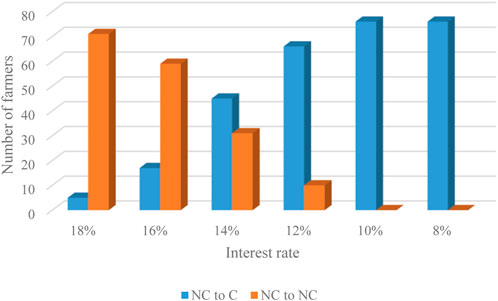
FIGURE 8. Analysis of the behavior of non-cooperative farmers with S1 and S2 policies. (NC to C: Changing from non-cooperative to cooperative behavior and NC to NC: Continue non-cooperative behavior).
The results demonstrated that the granting of facilities in an interest rate of 18% (the rate of the majority of facilities given in Iran) causes that only six cooperative farmers remain in a cooperative state and 18 of them have changed their behavior and they are not willing to accept the proposed plan. Despite the encouraging scenario of granting facilities for the development of new irrigation technologies, this behavior change is caused by the social pressures of farmers, because the attitude of the majority of the present sample is not cooperative (76 people out of 100) and this will lead to a change in the behavior of cooperative farmers. As shown in Figure 7, the reduction of the interest rate of facility makes more cooperating farmers continue their cooperative behavior with the proposed plan. In the interest rate of 12%, the number of farmers who will continue to participate in the proposed plan will be more than the number of non-cooperative farmers, and in the interest rate of 8%, all the cooperative farmers will remain in a cooperative state without changing their behavior.
According to Figure 8, granting facilities in an interest rate of 18% cannot persuade non-cooperative farmers to participate in the proposed policies. However, out of 76 non-cooperative farmers, only five individuals were willing to change their behavior towards participation. However, with the reduction of interest rate, more farmers are encouraged to change their behavior and adopt the proposed policies. At the interest rate of 14%, the number of farmers who change their behavior and participate in the proposed policies are more than the farmers who remain in the non-cooperative state. Also, the scenario of granting facilities in an interest rate of 10% is considered as a suitable incentive to change the behavior of non-cooperating farmers and can make all non-accepting farmers accept the proposed policies.
Also, Figure 9 showed that granting facilities for the development of new irrigation technologies with the current interest rate of facilities in Iran (18%) cannot lead farmers to adopt these technologies as well as the proposed pattern based on the WEFN. Based on the obtained results, reducing the interest rate of granted facilities to 14% will make it possible to accept the proposed policies by more than half of the farmers in the present sample of study. Also, at an interest rate of 8%, all farmers are willing to adopt the proposed pattern based on the WEFN to achieve the goals of sustainable economic development and use new irrigation technologies to reduce water consumption. In general, it can be said that not considering the cooperative behavior of farmers in WSRs can result into to the failure of the proposed programs and pattern, and farmers should be encouraged to participate more in water resources management plans (Akhbari and Grigg, 2015; Farhadi et al., 2016; Mirzaei and Zibaei, 2021; Mirzaei and Azarm, 2022).
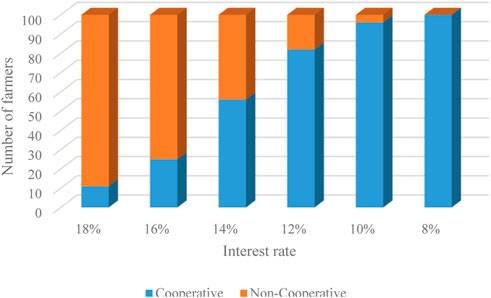
FIGURE 9. The level of cooperative and non-cooperative of farmers under social pressure and incentive policy options.
5 Conclusion
Sustainable economic development in the agricultural sector will not be achieved without paying attention to the sustainable consumption of resources such as water and energy in this sector. In this regard, the resources allocation pattern based on the WEFN can make it possible to achieve sustainable economic development in the agricultural sector. At the same time, the implementation of pattern based on WEFN in WSRs faces many challenges. The lack of water resources to improve the physical and economic productivity of water and energy as the main criteria in the WEFN will lead to farmers not adopting these patterns. Therefore, in the present study, the implementation analysis of the pattern based on the WEFN in WSRs was analyzed. For this purpose, the irrigation network of Doroodzan Dam in Fars province in Iran was selected as a WSR and the pattern based on WEFN was extracted using the combination of FAHP and TOPSIS methods. The results showed that the proposed pattern based on the WEFN will improve the physical and economic productivity of water and energy, but will not reduce water consumption. Therefore, the use of the WEFN-based pattern by farmers in the WSR requires encouraging farmers to reduce the consumption of water resources through government policy options. In this study, the policy of granting facilities at different interest rates to expand the use of new irrigation technologies was evaluated. In this regard, the ABM was used to analyze the cooperative behavior of farmers with incentive policy options. The results showed that the farmers of the studied area are resistant and would not be willing to accept the use of new irrigation technologies and the pattern based on the WEFN. This is despite the fact that reducing the interest rate of granted facilities can encourage cooperative farmers to continue this behavior and non-cooperative farmers to change their behavior. In general, it can be concluded that only the extraction of patterns based on the WEFN cannot lead to the sustainable economic development of the agricultural sector, and the evaluation of the implementation of these patterns is of great importance, especially in regions with water resource crisis. Therefore, it seems necessary to pay attention to the status of water resources in the studied agricultural regions as well as the behavior of farmers in those regions. Finally, it is suggested that for future studies, the conceptual framework of the present study should be used to apply researches in the field of WEFN. In addition, it is suggested that due to the effect of climate change on the proposed cultivation pattern and the subsequent change in the agents’ behavior, in future studies, the role of this important factor in modeling the WEF nexus is addressed.
Data availability statement
The raw data supporting the conclusion of this article will be made available by the authors, without undue reservation.
Ethics statement
Written informed consent was obtained from the individual(s) for the publication of any potentially identifiable images or data included in this article.
Author contributions
All authors contributed to the study conception and design. Material preparation, data collection and analysis were performed by [AM, NA, and MN]. The first draft of the manuscript was written by [AM] and all authors commented on previous versions of the manuscript. All authors read and approved the final manuscript.
Funding
This work was supported by (the Research and Technology Deputy of Agricultural Sciences and Natural Resources University of Khuzestan) [Grant numbers (1400.02)]. Corresponding author has received research support.
Acknowledgments
This study is a part of research (Evaluation of policy options to encourage farmers to adopt the optimal pattern of water-energy-food nexus: Application of agent-based model (No. 1400.02) with the support of the Research and Technology Deputy of Agricultural Sciences and Natural Resources University of Khuzestan.
Conflict of interest
The authors declare that the research was conducted in the absence of any commercial or financial relationships that could be construed as a potential conflict of interest.
Publisher’s note
All claims expressed in this article are solely those of the authors and do not necessarily represent those of their affiliated organizations, or those of the publisher, the editors and the reviewers. Any product that may be evaluated in this article, or claim that may be made by its manufacturer, is not guaranteed or endorsed by the publisher.
References
Abdelkader, A., and Elshorbagy, A. (2021). Acpar: A framework for linking national water and food security management with global conditions. Adv. Water Resour. 147, 103809. doi:10.1016/j.advwatres.2020.103809
Akhbari, M., and Grigg, N. S. (2013). A framework for an agent-based model to manage water resources conflicts. Water Resour. Manag. 27 (11), 4039–4052. doi:10.1007/s11269-013-0394-0
Akhbari, M., and Grigg, N. S. (2015). Managing water resources conflicts, Modelling behavior in a decision tool. Water Resour. Manag. 29 (14), 5201–5216. doi:10.1007/s11269-015-1113-9
Albrecht, T. R., Crootof, A., and Scott, C. A. (2018). The water-energy-food nexus: A systematic review of methods for nexus assessment. Environ. Res. Lett. 13 (4), 043002. doi:10.1088/1748-9326/aaa9c6
Bandini, S., Manzoni, S., and Vizzari, G. (2009). Agent based modeling and simulation: An informatics perspective.J. Artif. Soc. Soc. Simul., 12(4), 4.
Bizikova, L., Roy, D., Swanson, D., Venema, H. D., and McCandless, M. (2013).The water-energy-food security nexus: Towards a practical planning and decision-support framework for landscape investment and risk management. Winnipeg: International Institute for Sustainable Development.
Chen, Y., He, L., Guan, Y., Lu, H., and Li, J. (2017). Life cycle assessment of greenhouse gas emissions and water-energy optimization for shale gas supply chain planning based on multi-level approach: Case study in Barnett, Marcellus, Fayetteville, and Haynesville shales. Energy Convers. Manag. 134, 382–398. doi:10.1016/j.enconman.2016.12.019
Dizdaroglu, D. (2017). The role of indicator-based sustainability assessment in policy and the decision-making process: A review and outlook. Sustainability 9(6), 1018. doi:10.3390/su9061018
Edwards, M., Ferrand, N., Goreaud, F., and Huet, S. (2005). The relevance of aggregating a water consumption model cannot be disconnected from the choice of information available on the resource. Simul. Model. Pract. Theory 13 (4), 287–307. doi:10.1016/j.simpat.2004.11.008
El-Gafy, I., Grigg, N., and Waskom, R. (2017). Water-food-energy: Nexus and non-nexus approaches for optimal cropping pattern. Water Resour. Manag. 31 (15), 4971–4980. doi:10.1007/s11269-017-1789-0
El-Gafy, I. (2017). Water–food–energy nexus index: Analysis of water–energy–food nexus of crop’s production system applying the indicators approach. Appl. Water Sci. 7 (6), 2857–2868. doi:10.1007/s13201-017-0551-3
FAO (2011). Water is key to food security. Retrieved from; http://www.fao.org/news/story/it/item/86991/icode/(Accessed February 21, 2020).
Farhadi, S., Nikoo, M. R., Rakhshandehroo, G. R., Akhbari, M., and Alizadeh, M. R. (2016). An agent-based-nash modeling framework for sustainable groundwater management: A case study. Agric. Water Manag. 177, 348–358. doi:10.1016/j.agwat.2016.08.018
Farinha, F., Oliveira, M. J., Silva, E. M., Lança, R., Pinheiro, M. D., and Miguel, C. (2019). Selection process of sustainable indicators for the algarve region—observe project.Sustainability, 11(2), 444.doi:10.3390/su11020444
Gain, A. K., Giupponi, C., and Benson, D. (2015). The water–energy–food (WEF) security nexus: The policy perspective of Bangladesh. Water Int. 40 (5-6), 895–910. doi:10.1080/02508060.2015.1087616
Gandomkar, A., and Dehghani, R. (2012). Study of temperature changes in Fars province. Int. J. Geol. Environ. Eng. 6 (3), 127–129.
González-Bravo, R., Sauceda-Valenzuela, M., Mahlknecht, J., Rubio-Castro, E., and Ponce-Ortega, J. M. (2018). Optimization of water grid at macroscopic level analyzing water-energy-food nexus. ACS Sustain. Chem. Eng. 6 (9), 12140–12152. doi:10.1021/acssuschemeng.8b02484
Guan, X., Mascaro, G., Sampson, D., and Maciejewski, R. (2020). A metropolitan scale water management analysis of the food-energy-water nexus. Sci. Total Environ. 701, 134478. doi:10.1016/j.scitotenv.2019.134478
Guo, N., Shi, C., Yan, M., Gao, X., and Wu, F. (2022). Modeling agricultural water-saving compensation policy: An ABM approach and application. J. Clean. Prod. 344, 131035. doi:10.1016/j.jclepro.2022.131035
Hoff, H. (2011). Understanding the nexus. Background paper for the bonn 2011 nexus conference: The water, energy and food security nexus. Stockholm: Stockholm Environment Institute.
Hoolohan, C., Larkin, A., McLachlan, C., Falconer, R., Soutar, I., Suckling, J., et al. (2018). Engaging stakeholders in research to address water–energy–food (WEF) nexus challenges. Sustain. Sci. 13 (5), 1415–1426. doi:10.1007/s11625-018-0552-7
Hu, M. C., Fan, C., Huang, T., Wang, C. F., and Chen, Y. H. (2019). Urban metabolic analysis of a food-water-energy system for sustainable resources management. Int. J. Environ. Res. public health 16, 90. doi:10.3390/ijerph16010090
Hung, A. H. P. (2002). Virtual water trades a quantification of virtual water flows between nations in relation to international crop trade. Water Sci. Technol. 49, 203–209.
Jalilov, S. M., Keskinen, M., Varis, O., Amer, S., and Ward, F. A. (2016). Managing the water–energy–food nexus: Gains and losses from new water development in Amu Darya River Basin. J. Hydrology 539, 648–661. doi:10.1016/j.jhydrol.2016.05.071
Karabulut, A., Egoh, B. N., Lanzanova, D., Grizzetti, B., Bidoglio, G., Pagliero, L., et al. (2016). Mapping water provisioning services to support the ecosystem–water–food–energy nexus in the Danube River basin. Ecosyst. Serv. 17, 278–292. doi:10.1016/j.ecoser.2015.08.002
Lee, S. H., Choi, J. Y., Yoo, S. H., and Mohtar, R. H. (2020). “Water footprint for Korean rice products and virtual water trade in a water-energy-food nexus”. InVirtual water. UK; Routledge.
Li, M., Fu, Q., Singh, V. P., Ji, Y., Liu, D., Zhang, C., et al. (2019a). An optimal modelling approach for managing agricultural water-energy-food nexus under uncertainty. Sci. Total Environ. 651, 1416–1434. doi:10.1016/j.scitotenv.2018.09.291
Li, M., Fu, Q., Singh, V. P., Liu, D., and Li, T. (2019b). Stochastic multi-objective modeling for optimization of water-food-energy nexus of irrigated agriculture. Adv. water Resour. 127, 209–224. doi:10.1016/j.advwatres.2019.03.015
Li, M., Zhao, L., Zhang, C., Liu, Y., and Fu, Q. (2022). Optimization of agricultural resources in water-energy-food nexus in complex environment: A perspective on multi-energy coordination. Energy Convers. Manag. 258, 115537. doi:10.1016/j.enconman.2022.115537
Mayor, B., López-Gunn, E., Villarroya, F. I., and Montero, E. (2015). Application of a water–energy–food nexus framework for the Duero River basin in Spain. Water Int. 40 (5-6), 791–808. doi:10.1080/02508060.2015.1071512
Mirzaei, A., Abdeshahi, A., Azarm, H., and Naghavi, S. (2022a). New design of water-energy-food-environment nexus for sustainable agricultural management. Stoch. Environ. Res. Risk Assess. 36 (7), 1861–1874. doi:10.1007/s00477-021-02131-9
Mirzaei, A., and Azarm, H. (2022). Evaluation of farmers' participatory behavior and compensation policy for agricultural water-saving. Front. Water 4, 1005821. doi:10.3389/frwa.2022.1005821
Mirzaei, A., Azarm, H., Yazdanpanah, M., and Najafabadi, M. M. (2022b). Socio-economic, social-capital, and psychological characteristics and climate change adaptive behavior of farmers in Iran. Clim. Res. 87, 1–12. doi:10.3354/cr01683
Mirzaei, A., and Zibaei, M. (2021). Water conflict management between agriculture and wetland under climate change: Application of economic-hydrological-behavioral modelling. Water Resour. Manag. 35 (1), 1–21. doi:10.1007/s11269-020-02703-4
Nahidul Karim, M., and Daher, B. (2021). Evaluating the potential of a water-energy-food nexus approach toward the sustainable development of Bangladesh.Water, 13(3), 366.doi:10.3390/w13030366
Nhamo, L., Mabhaudhi, T., Mpandeli, S., Dickens, C., Nhemachena, C., Senzanje, A., et al. (2020). An integrative analytical model for the water-energy-food nexus: South Africa case study. Environ. Sci. Policy 109, 15–24. doi:10.1016/j.envsci.2020.04.010
Pastor, A. V., Palazzo, A., Havlik, P., Biemans, H., Wada, Y., Obersteiner, M., et al. (2019). The global nexus of food–trade–water sustaining environmental flows by 2050. Nat. Sustain. 2 (6), 499–507. doi:10.1038/s41893-019-0287-1
Radmehr, R., Ghorbani, M., and Ziaei, A. N. (2021). Quantifying and managing the water-energy-food nexus in dry regions food insecurity: New methods and evidence. Agric. Water Manag. 245, 106588. doi:10.1016/j.agwat.2020.106588
Ramaswami, A., Boyer, D., Nagpure, A. S., Fang, A., Bogra, S., Bakshi, B., et al. (2017). An urban systems framework to assess the trans-boundary food-energy-water nexus: Implementation in Delhi, India. Environ. Res. Lett. 12 (2), 025008. doi:10.1088/1748-9326/aa5556
Sadeghi, S. H., Moghadam, E. S., Delavar, M., and Zarghami, M. (2020). Application of water-energy-food nexus approach for designating optimal agricultural management pattern at a watershed scale. Agric. Water Manag. 233, 106071. doi:10.1016/j.agwat.2020.106071
Saray, M. H., Baubekova, A., Gohari, A., Eslamian, S. S., Klove, B., and Haghighi, A. T. (2022). Optimization of water-energy-food nexus considering CO2 emissions from cropland: A case study in northwest Iran. Appl. Energy 307, 118236. doi:10.1016/j.apenergy.2021.118236
Scott, C. A., Kurian, M., and Wescoat, J. L. (2015). “The water-energy-food nexus: Enhancing adaptive capacity to complex global challenges,” in Governing the nexus. Editors M. Kurian, and R. Ardakanian (Cham: Springer).
Steffen, W., Richardson, K., Rockström, J., Cornell, S. E., Fetzer, I., and Bennett, E. M., (2015). Sustainability Planetary boundaries: Guiding human development on a changing planet. Science, 347, 1259855. doi:10.1126/science.1259855
Stephan, R. M., Mohtar, R. H., Daher, B., Embid Irujo, A., Hillers, A., Ganter, J. C., et al. (2018). Water–energy–food nexus: A platform for implementing the sustainable development goals. Water Int. 43 (3), 472–479. doi:10.1080/02508060.2018.1446581
Sun, J., Li, Y. P., Suo, C., and Liu, J. (2020). Development of an uncertain water-food-energy nexus model for pursuing sustainable agricultural and electric productions. Agric. Water Manag. 241, 106384. doi:10.1016/j.agwat.2020.106384
Tan, A. H. P., and Yap, E. H. (2019). Energy security within Malaysia’s water-energy-food nexus—A systems approach.Systems, 7(1), 14.doi:10.3390/systems7010014
Vanham, D., Leip, A., Galli, A., Kastner, T., Bruckner, M., Uwizeye, A., et al. (2019). Environmental footprint family to address local to planetary sustainability and deliver on the SDGs. Sci. Total Environ. 693, 133642. doi:10.1016/j.scitotenv.2019.133642
Wa'el A, H., Memon, F. A., and Savic, D. A. (2018). A risk-based assessment of the household water-energy-food nexus under the impact of seasonal variability. J. Clean. Prod. 171, 1275–1289. doi:10.1016/j.jclepro.2017.10.094
Wen, C., Dong, W., Zhang, Q., He, N., and Li, T. (2022). A system dynamics model to simulate the water-energy-food nexus of resource-based regions: A case study in daqing city, China. Sci. Total Environ. 806, 150497. doi:10.1016/j.scitotenv.2021.150497
White, D. D., Jones, J. L., Maciejewski, R., Aggarwal, R., and Mascaro, G. (2017). Stakeholder analysis for the food-energy-water nexus in Phoenix, Arizona: Implications for nexus governance.Sustainability, 9(12), 2204.doi:10.3390/su9122204
Wicaksono, A., and Kang, D. (2019). Nationwide simulation of water, energy, and food nexus: Case study in South Korea and Indonesia. J. Hydro-Environment Res. 22, 70–87. doi:10.1016/j.jher.2018.10.003
Xiao, Z., Yao, M., Tang, X., and Sun, L. (2019). Identifying critical supply chains: An input-output analysis for food-energy-water nexus in China. Ecol. Model. 392, 31–37. doi:10.1016/j.ecolmodel.2018.11.006
Yu, L., Xiao, Y., Zeng, X. T., Li, Y. P., and Fan, Y. R. (2020). Planning water-energy-food nexus system management under multi-level and uncertainty. J. Clean. Prod. 251, 119658. doi:10.1016/j.jclepro.2019.119658
Keywords: water-energy-food nexus (WEFN), water-scarce regions (WSRs), multi-criteria decision making (MCDM), agent-based model (ABM), water-scarce regions
Citation: Mirzaei A, Ashktorab N and Noshad M (2023) Evaluation of the policy options to adopt a water-energy-food nexus pattern by farmers: Application of optimization and agent-based models. Front. Environ. Sci. 11:1139565. doi: 10.3389/fenvs.2023.1139565
Received: 07 January 2023; Accepted: 27 February 2023;
Published: 10 March 2023.
Edited by:
Robert Larkin, Agricultural Research Service (USDA), United StatesReviewed by:
Alex Oriel Godoy, Universidad del Desarrollo, ChileYing Zhu, Xi’an University of Architecture and Technology, China
Copyright © 2023 Mirzaei, Ashktorab and Noshad. This is an open-access article distributed under the terms of the Creative Commons Attribution License (CC BY). The use, distribution or reproduction in other forums is permitted, provided the original author(s) and the copyright owner(s) are credited and that the original publication in this journal is cited, in accordance with accepted academic practice. No use, distribution or reproduction is permitted which does not comply with these terms.
*Correspondence: Abbas Mirzaei, YW1pcnphZWlAYXNucnVraC5hYy5pcg==
 Abbas Mirzaei
Abbas Mirzaei Niloofar Ashktorab
Niloofar Ashktorab Mohammad Noshad
Mohammad Noshad